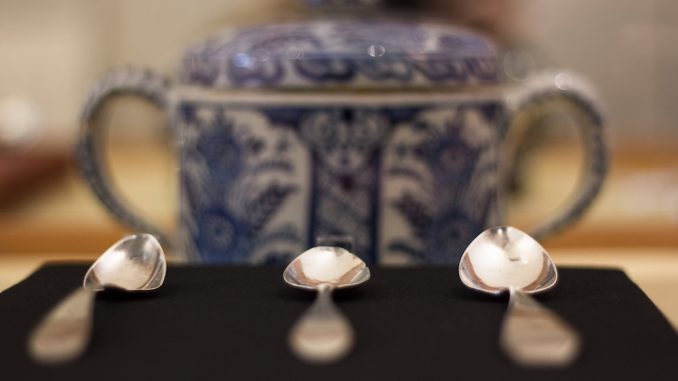
Historic Huguenot Street, a national historic landmark located in SUNY New Paltz’s backyard, transcends the concept of “knowing your roots” with the introduction of its new exhibit, “Dutch Silver Spoons.”
Upon entering the exhibit, visitors can breathe easy knowing that the staff at the visitor center provides a wealth of information, and their attention to detail leaves nothing to the imagination. Accurately representing the symbolic importance of these cultural artifacts is of the highest priority to the accommodating employees.
As visitors are led through the charming visitor center, an air of surrealism permeates the atmosphere. Suddenly, while walking through the low archways, the clock rolls back to the 1600s, when the Huguenots first made their mark on this town, and the problems of today no longer exist. The glass cases are pristine; the spoons are artfully arranged to highlight the intricate and ornate design of each utensil and the tape recording being played on a loop intensifies the idea that these were once not history, but a part of life.
According to officials at Historic Huguenot Street, the spoons, during their time of creation, were an outlet for artistic expression and given as tokens. To commemorate birthdays, marriages and even death and divorce, the spoons were designed specifically to represent the importance of the event. The creativity behind the spoons cannot be accredited to the Huguenots though, but the settlers who were there before them and “showed them the ropes:” the Dutch.
Courtney Russo, guest experience coordinator at Historic Huguenot Street, said that while the “entire landmark is a testament to how New Paltz is truly just one large melting pot of cultures, the exhibit focuses on the influence the Dutch had on the early Huguenots.”
Fleeing from religious persecution approximately 300 years ago, the Huguenots took a leap of faith and traveled across seas from die Pfalz, Germany to Wiltwijck, otherwise known as Kingston, New York. A new opportunity for freedom, the Huguenots found refuge in the New World where they were greeted by the Dutch settlers who had voyaged before them. With their new life, the Huguenots embraced the melding of cultures: their own culture with the cultures of the Esopus (the Native American tribe that had inhabited the area), the African slaves and more specifically, the culture of the Dutch settlers.
Interacting with the Dutch not only led to intermarriages and crossed bloodlines, but the adoption of the Dutch culture. This included anything from religious practices to the architecture that can still be seen standing today at the landmark to the spoons themselves.
With as little as one walk around the room, first-year psychology major Rebecca Walsh said that “the exhibit was charming” and inspired her to “look up the history of the town.”
“I took every pamphlet the center offered regarding the spoons,” she said with excitement.
Though focused on the Dutch silver spoons specifically, the staff placed other spoons around the room for comparison. This included spoons from the time of the Huguenots’ voyage over from Europe: English spoons, Germans spoons and French spoons. This small detail illuminated the uniqueness of these cultural artifacts and put in perspective how delicate and precious these spoons had been to their creators.
First-year theater arts major Brittany Hernandez said that the exhibit was breathtaking.
“It’s amazing how these people took care to even create beauty in something as simple as a spoon,” she said.
Locals and guests alike can view these historic spoons at the Historic Huguenot Street visitor center from Oct. 1 through Dec. 18. Guests can send questions to Russo via email at Courtney@huguenotstreet.org.
